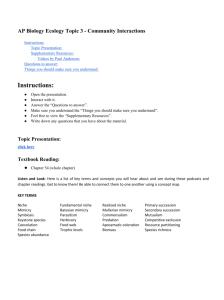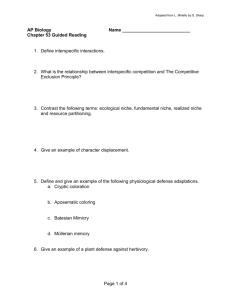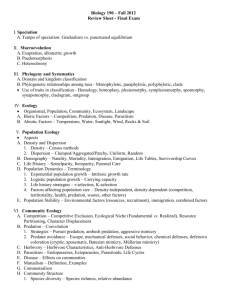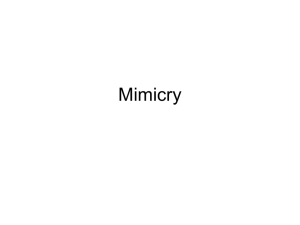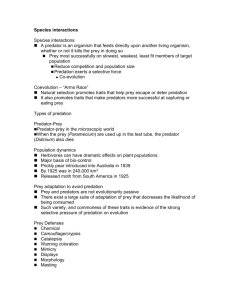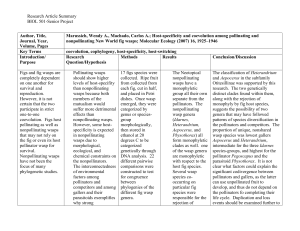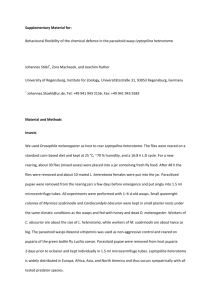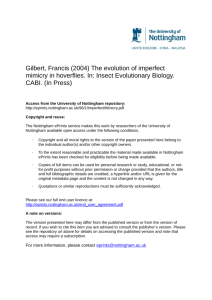M Drees (1997) - Behaviour and Ecology at Nottingham
advertisement
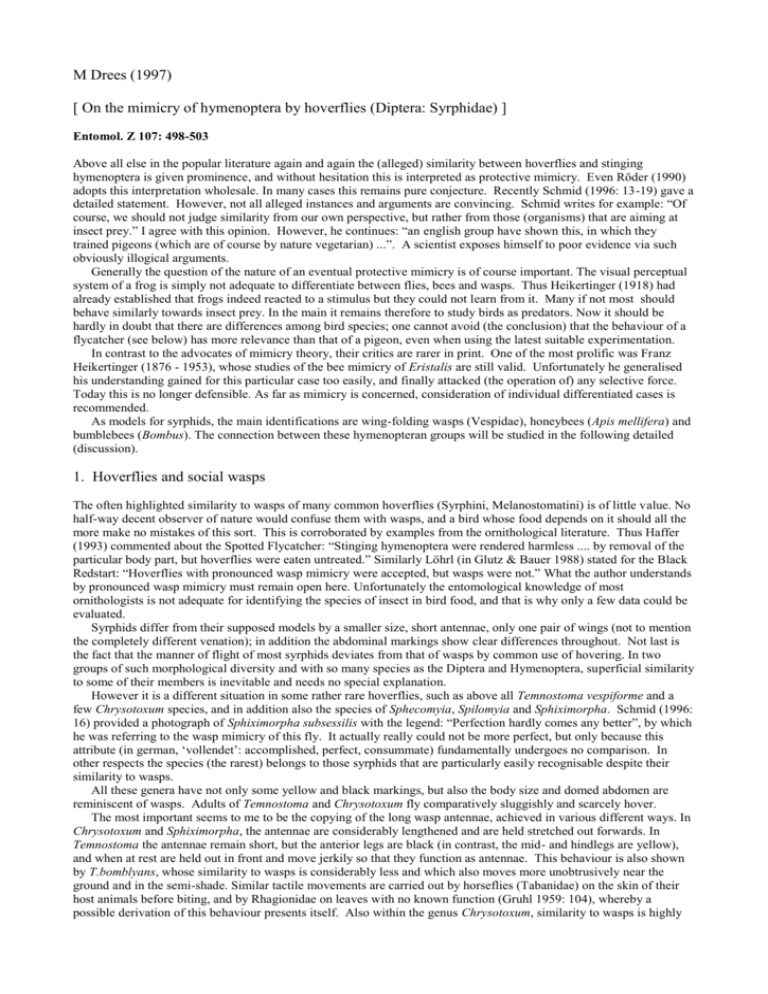
M Drees (1997) [ On the mimicry of hymenoptera by hoverflies (Diptera: Syrphidae) ] Entomol. Z 107: 498-503 Above all else in the popular literature again and again the (alleged) similarity between hoverflies and stinging hymenoptera is given prominence, and without hesitation this is interpreted as protective mimicry. Even Röder (1990) adopts this interpretation wholesale. In many cases this remains pure conjecture. Recently Schmid (1996: 13-19) gave a detailed statement. However, not all alleged instances and arguments are convincing. Schmid writes for example: “Of course, we should not judge similarity from our own perspective, but rather from those (organisms) that are aiming at insect prey.” I agree with this opinion. However, he continues: “an english group have shown this, in which they trained pigeons (which are of course by nature vegetarian) ...”. A scientist exposes himself to poor evidence via such obviously illogical arguments. Generally the question of the nature of an eventual protective mimicry is of course important. The visual perceptual system of a frog is simply not adequate to differentiate between flies, bees and wasps. Thus Heikertinger (1918) had already established that frogs indeed reacted to a stimulus but they could not learn from it. Many if not most should behave similarly towards insect prey. In the main it remains therefore to study birds as predators. Now it should be hardly in doubt that there are differences among bird species; one cannot avoid (the conclusion) that the behaviour of a flycatcher (see below) has more relevance than that of a pigeon, even when using the latest suitable experimentation. In contrast to the advocates of mimicry theory, their critics are rarer in print. One of the most prolific was Franz Heikertinger (1876 - 1953), whose studies of the bee mimicry of Eristalis are still valid. Unfortunately he generalised his understanding gained for this particular case too easily, and finally attacked (the operation of) any selective force. Today this is no longer defensible. As far as mimicry is concerned, consideration of individual differentiated cases is recommended. As models for syrphids, the main identifications are wing-folding wasps (Vespidae), honeybees (Apis mellifera) and bumblebees (Bombus). The connection between these hymenopteran groups will be studied in the following detailed (discussion). 1. Hoverflies and social wasps The often highlighted similarity to wasps of many common hoverflies (Syrphini, Melanostomatini) is of little value. No half-way decent observer of nature would confuse them with wasps, and a bird whose food depends on it should all the more make no mistakes of this sort. This is corroborated by examples from the ornithological literature. Thus Haffer (1993) commented about the Spotted Flycatcher: “Stinging hymenoptera were rendered harmless .... by removal of the particular body part, but hoverflies were eaten untreated.” Similarly Löhrl (in Glutz & Bauer 1988) stated for the Black Redstart: “Hoverflies with pronounced wasp mimicry were accepted, but wasps were not.” What the author understands by pronounced wasp mimicry must remain open here. Unfortunately the entomological knowledge of most ornithologists is not adequate for identifying the species of insect in bird food, and that is why only a few data could be evaluated. Syrphids differ from their supposed models by a smaller size, short antennae, only one pair of wings (not to mention the completely different venation); in addition the abdominal markings show clear differences throughout. Not last is the fact that the manner of flight of most syrphids deviates from that of wasps by common use of hovering. In two groups of such morphological diversity and with so many species as the Diptera and Hymenoptera, superficial similarity to some of their members is inevitable and needs no special explanation. However it is a different situation in some rather rare hoverflies, such as above all Temnostoma vespiforme and a few Chrysotoxum species, and in addition also the species of Sphecomyia, Spilomyia and Sphiximorpha. Schmid (1996: 16) provided a photograph of Sphiximorpha subsessilis with the legend: “Perfection hardly comes any better”, by which he was referring to the wasp mimicry of this fly. It actually really could not be more perfect, but only because this attribute (in german, ‘vollendet’: accomplished, perfect, consummate) fundamentally undergoes no comparison. In other respects the species (the rarest) belongs to those syrphids that are particularly easily recognisable despite their similarity to wasps. All these genera have not only some yellow and black markings, but also the body size and domed abdomen are reminiscent of wasps. Adults of Temnostoma and Chrysotoxum fly comparatively sluggishly and scarcely hover. The most important seems to me to be the copying of the long wasp antennae, achieved in various different ways. In Chrysotoxum and Sphiximorpha, the antennae are considerably lengthened and are held stretched out forwards. In Temnostoma the antennae remain short, but the anterior legs are black (in contrast, the mid- and hindlegs are yellow), and when at rest are held out in front and move jerkily so that they function as antennae. This behaviour is also shown by T.bomblyans, whose similarity to wasps is considerably less and which also moves more unobtrusively near the ground and in the semi-shade. Similar tactile movements are carried out by horseflies (Tabanidae) on the skin of their host animals before biting, and by Rhagionidae on leaves with no known function (Gruhl 1959: 104), whereby a possible derivation of this behaviour presents itself. Also within the genus Chrysotoxum, similarity to wasps is highly variable, and the commonest species Chrysotoxum bicinctum in many places (as in my study sites in the Hagen area) is far from the best. The Volucella species that develop in wasps nests are completely different from their hosts, which is particularly true for the commonest and most “effective” species in this regard, V.pellucens, despite the females of this species needing to penetrate into wasp nests to lay their eggs (cf. the cited literature in Barkemeyer 1994). V.inflata is a little more wasp-like; we do not know whether this species actually has any relationship with wasps. The series of forms continues with V.inanis and V.zonaria, which because of their size resemble in flight above all a hornet. The colouring and markings vary widely in this genus unconnected with their life cycle. On the other hand it is known that Syrphus (sens.lat.) species are often recorded as prey items of wasps (Kemper & Döhring 1967). As beneficiaries, mimicry should eliminate them from this. For this reason one can talk about only a few hoverflies as having good evidence for wasp mimicry. Also the protective effect should be limited to particular predators and play a much smaller role in the life of animals than one might assume from unthinking anthropomorphic ways of thinking. Selection for mimicry should first become effective at a later time, after other elements are already present. Because the latter have different origins (see above), several evolutionary lines unconnected with ecah other are undoubtedly present. It has already been mentioned that all convincing wasp mimics are rare. This corresponds to a rule of Wallace, whereby mimics should not be as common as their models. This requirement is functionally obvious, and at the same time places rigid boundaries to the biological consequences for a species that puts its faith in mimicry. Imitation is therefore no general practicable prescription, although not only it itself but also the protection of the model in fact should fail once it is ‘perfect’. This way is beneficial only therefore when the population density of the relevant species is already limited to within narrow bounds in another way, for which Sphiximorpha subsessilis provides an excellent example through its adaptation to a very specialized larval habitat. 2. Hoverflies and honeybees In constrast to wasps, honeybees do not have warning colours, but are cryptic. Heikertinger (1918) had already drawn attention to the fact that this runs contrary to the assumptions of mimicry. Despite the absence of any striking special markings, Apis mellifera is also often cited as a model for the presence of body features of insects. However, in the literature honeybee mimicry is ascribed above all to Eristalis species. Heikertinger (1918) has already argued with this hypothesis in detail; most of the following ideas are to be found in his work (partly in modified form). Most of all the robust E.tenax seems indeed similar to a honeybee, especially the reddish patches at the base of the abdomen which also appear on the same positions on Apis mellifera; the former as a consequence carries the popular name of Pretend-bee or Dung-bee. But this similarity is more striking than useful. The construction of the antennae of the fly is not modified and allows an immediate differentiation. Also their behaviour while visiting flowers is different, more restless than the foraging honeybee. Despite his myopia, Heikertinger had no difficulty in distinguishing dungbees from honeybees. It is also worth mentioning that Eristalis tenax particularly resembles a drone (it is called a dronefly in english). However this is of no direct benefit, and birds that ‘know’ this can exploit it. Near beehives nesting flycatchers hunt drones, but leave workers unmolested (Grobelny 1962). A similar well developed ability to differentiate is also known in Bee-eaters: “even very bee-like hoverflies (Syrphidae) were recognized as harmless and treated correspondingly” (Chaplin 1937). Heikertinger’s comments on E.tenax have not been opposed and there is little to add. He named sundry other birds as “feeders on bees” (in addition to the bee-eaters already mentioned), while scarcely a single species is known that shuns these insects despite their sting. Because this is so, the question arises as to how the poisonous sting of honeybees can be maintained in good order. Since Heikertinger left this open, a small digression is permitted here. Bees could hardly ever use their sting against the attacks of crab spiders (Thomisidae), robberflies (Asilidae) and the beewolf (Philanthus). It is also known that the sting remains stuck in the skin of mammals (and indeed also in birds), which leads to the death of the worker from evisceration. The stung therefore does not protect the life of the worker, but in opportune cases via self-sacrifice it protects rather the beehive from being plundered. This interpretation also requires no warning colours of the bees. Röder (1990) labelled still more hoverflies as honeybee mimics, in addition to Eristalis species: Cheilosia canicularis, Criorhina asilica and Brachypalpus laphriformis. Since he wrote about Ch.canicularis that its behaviour on composite flowers corresponds to that of the honeybee, he must have at least observed them poorly. A worker honeybee does not remain “powdered” for long, but tries to wipe the pollen off as completely as possible into its pollen sacs. As for Brachypalpus laphriformis and Criorhina asilica, we can say that they visit flowers relatively rarely, but often lie in wait on tree-trunks or are encountered sunning themselves, and hence they behave differently from honeybees. They are difficult to see on bark, so that we should be considering them as cryptic. 3. Hoverflies and bumblebees Here we have first to record that bumblebees do not belong to the insects to be frightened of, but rather (as Apis) are caputed regularly by many birds. This occurs not only in bird species that, interpreting liberally, we can identify as specialists (Bee-eaters, Red-Backed Shrikes), but also generalists such as the Great Tit. Above all we should consider whether a very hairy insect of a corresponding size inevitably resembles one or another bumblebee species, since in the genus Bombus (sens.lat.) almost all possible colour combinations are present. The primary function of fur is protection against the cold, and we should concede this for both bumblebees and hoverflies. It is striking that the most bumblebee-like syrphids are either mountain species (Eriozona, Arctophila bombiformis, Criorhina, etc., and indeed originally also Merodon equestris) or at least appear remarkably early (Mallota fuciformis, Criorhina ranunculi) or late (Arctophila superbiens, Mallota tricolor) in the year. The great variability of the hair colours, especially true in Merodon equestris, but also occurring in Volucella bombylans (see below) and Criorhina berberina, equally argues against mimicry (as a cause). For the purposes of heat insulation the colour is rather unimportant, and is subject to no strong selection pressure. In the case of protective mimicry, the opposite would be assumed. Confusion of bumblebees with conspecifics occurs throughout the flies. Thus male Volucella bombylans rise from their lookout positions and pursue bumblebees; indeed, in Merodon equestris actual attacks occur in the course of territorial defence. However, these are blunders that bring no advantage to the flies. Only Volucella bombylans keeps a close relationship with bumblebees, since the females penetrate the bumblebee nests to lay their eggs. Rupp (1989), who has made a detailed study of this species, accepts this as protective mimicry. In my opinion, however, his observations are rather against this. No morph-specific preference was established for the respective similar bumblebee species. The entry into the nest is only possible in an unguarded moment. If the fly is discovered in the nest, she could be thoroughly stung by bumblebees, but while dying she can still lay a series of eggs (details in Barkemeyer 1994: 243). 4. Similarity to other Hymenoptera Cheilosia chrysocoma is just as densely hairy as the bumblebee-like syrphids, but smaller. It resembles particular solitary bees of the genus Osmia and Andrena. Since these are not so popular (or at least so ‘ready to sting’) as bumblebees. Ch.chrysocoma has not until now been connected with mimicry. It is also an early species; my dates of observation lie between the 2nd April and 23rd May. In the similarly early flying but commoner Cheilosia albipila (not a montane species, and often hovering), the hair covering is incomplete, but in comparison with other congenerics is clearly longer and denser. Normally between these two species, but nearer to Ch.albipila, is Cheilosia grossa, another early spring species. In Cheilosia as in Chrysotoxum and Volucella we find a series of forms where sometimes, often in the final parts of the series, it reminds us of the habitus of unrelated insects. Hoverflies of the genera Syritta (‘small dung-bee: Frisch 1721), Eumerus and Pipizella resemble somewhat a small bee (Halictus s.l.), but like these are so inconspicuous that the idea of warning colouration is ruled out. Bothe (1994: 8) with good reasons referred to the similarity of Xylota species to sawflies, which also refers to the behaviour - quick running on leaves, broken by short flights. However these sawflies, particularly concerning representatives of the genus Macrophya, are ahrdly more noxious than the flies themselves, and could not be interpreted as protective models for mimicry. This case shows particularly clearly that striking similarity to the eye still does not correspond to any biological connection, and we should not hastily make such conclusions. Generally, proof of alleged cases of protective mimicry rests far too much, especially in popular representations, on similar sorts of apparently plausible possibilities. This deplorable situation was already complained of by Heikertinger in 1918, but is still not overcome today. This is all the more incomprehensible since the theory of resemblence on a general theoretical level is considered as a 100-yr-old outof-date first step in scientific thinking. transl FSG 12-5-2000

